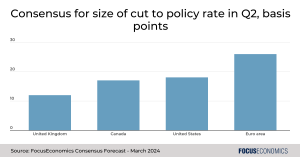Global monetary policy tightened considerably from 2021 to 2023, as central banks around the world looked to ward off elevated price pressures stemming from resurgent domestic demand and snarled-up supply chains. But interest rates peaked in the second half of last year, and now many are looking to the Fed rate, the ECB interest rate and other major banks’ policy rates to see when they will fall.
Switzerland leads the way
On 21 March, the Swiss National Bank (SNB) cut its policy rate from 1.75% to 1.50%, becoming the first major central bank to cut rates since the pandemic. The SNB found itself in the enviable position of managing an economy in which inflation is running at a little over 1% a year—less than half the rate in most developed economies—allowing it to loosen its stance earlier than other central banks.
The ECB interest rate could be next
Among other major central banks, our panelists expect the ECB interest rate to be the next to fall, likely by June. Inflation in the Euro area is currently running at only slightly above the Bank’s 2.0% target, and the economy is creaking under the impact of tight monetary policy—economic activity flatlined in Q4 2023, and GDP growth this year is expected to be less than a third of the rate in the U.S.
Canada, the UK and the U.S. could take slightly longer to cut rates
Our Consensus is less sure of Fed rate cuts and cuts by the banks of Canada and the UK in the second quarter, with many panelists expecting these countries’ central banks to wait until Q3 before cutting rates. However, our panel is virtually unanimous in judging that monetary policy will have been eased in all three countries by the end of this year, with around 90–100 basis points of cuts expected.
The upshot of monetary policy easing later this year will be a rebound in economic activity and a possible further upward surge in equity markets—which have already hit record highs in recent months.

Insight from our analyst network
On the ECB policy rate, EIU analysts said:
“The European Central Bank (ECB) is forecast to keep its policy rate at its current record high until mid-2024. This will keep borrowing and debt-servicing costs elevated for most of the year. We expect monetary easing to begin in June and to reduce the policy rate by 100 basis points by end-2024. This will have a tangible impact on credit conditions for households and businesses only from 2025.”
On the outlook for the Fed rate, Nomura analysts said:
“We maintain our expectation of just two rate cuts this year, in July and December. The dot distribution suggests the FOMC is divided between two and three cuts this year, and policymakers are likely to be sensitive to upside surprises in inflation data.”
Our latest analysis
Mexico’s economy had a weak start to 2024.
Japanese private-sector activity improved in March.
Download our free special report on the commodity price outlook


